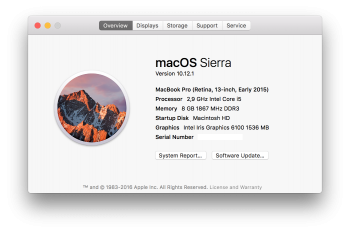Before the public version of macOS Sierra came out, I'd belonged to the public beta. When the public version was made available, I updated to it and subsequently turned off the setting that checks and installs future beta versions; however, something somewhere must not have received the message, and thus the next beta version that was pushed out got installed on my Mac. This version was a bit too buggy for me, so I began researching ways to go about getting back to the public version. Unfortunately, I don't own an external drive and have never had a justifiable enough reason to buy one, so a Time Machine backup was not an option.
I came across one method I'd used in the past, which involved tricking Software Update into thinking I was running an older version of the OS than the current public version of Sierra by changing the version numbers in the file SystemVersion.plist. It all seemed rather simple: I'd modify the file, get the update underway and then change it back, right? Well, not quite, as apparently Apple made modifying core, system files practically verboten with El Capitan. After further research, I found the workaround, which was to boot into Recovery Mode and temporarily disable the new System Integrity Protection feature. I did so and was then able to modify the file, start the update, revert the file change and install the public software with nary an issue. After it had been installed, I booted back into Recovery Mode and re-enabled SIP.
Everything seemed fine at first, but now my boot times have gone from mere seconds (up until today, I had the newest MBPr) to several minutes, and wake times aren't much better. When the latest public software update was released a few days ago, I did receive it, but I was only able to update via Terminal, as neither the soft restart buttons in Software Update/Mac App Store nor the one under the Apple menu did much of anything when they were pressed. In general, it gets quite sluggish at times (especially on boot/wake, not as bad once I'm actually using it), and I can't quite figure out why, let alone how to go about mending it.
Any help would be massively appreciated.
I came across one method I'd used in the past, which involved tricking Software Update into thinking I was running an older version of the OS than the current public version of Sierra by changing the version numbers in the file SystemVersion.plist. It all seemed rather simple: I'd modify the file, get the update underway and then change it back, right? Well, not quite, as apparently Apple made modifying core, system files practically verboten with El Capitan. After further research, I found the workaround, which was to boot into Recovery Mode and temporarily disable the new System Integrity Protection feature. I did so and was then able to modify the file, start the update, revert the file change and install the public software with nary an issue. After it had been installed, I booted back into Recovery Mode and re-enabled SIP.
Everything seemed fine at first, but now my boot times have gone from mere seconds (up until today, I had the newest MBPr) to several minutes, and wake times aren't much better. When the latest public software update was released a few days ago, I did receive it, but I was only able to update via Terminal, as neither the soft restart buttons in Software Update/Mac App Store nor the one under the Apple menu did much of anything when they were pressed. In general, it gets quite sluggish at times (especially on boot/wake, not as bad once I'm actually using it), and I can't quite figure out why, let alone how to go about mending it.
Any help would be massively appreciated.
Attachments
Last edited:


